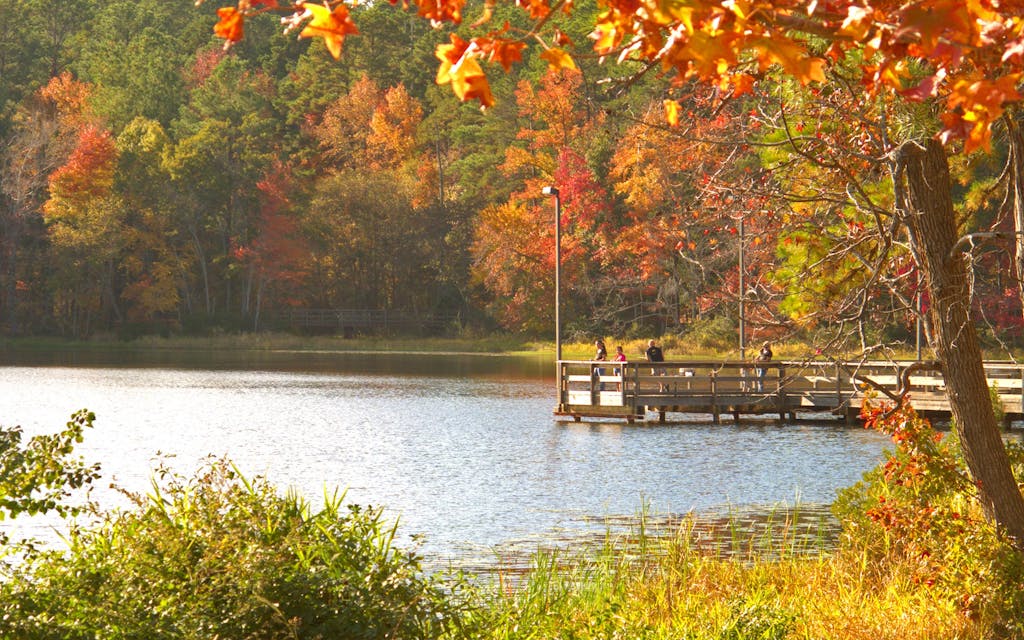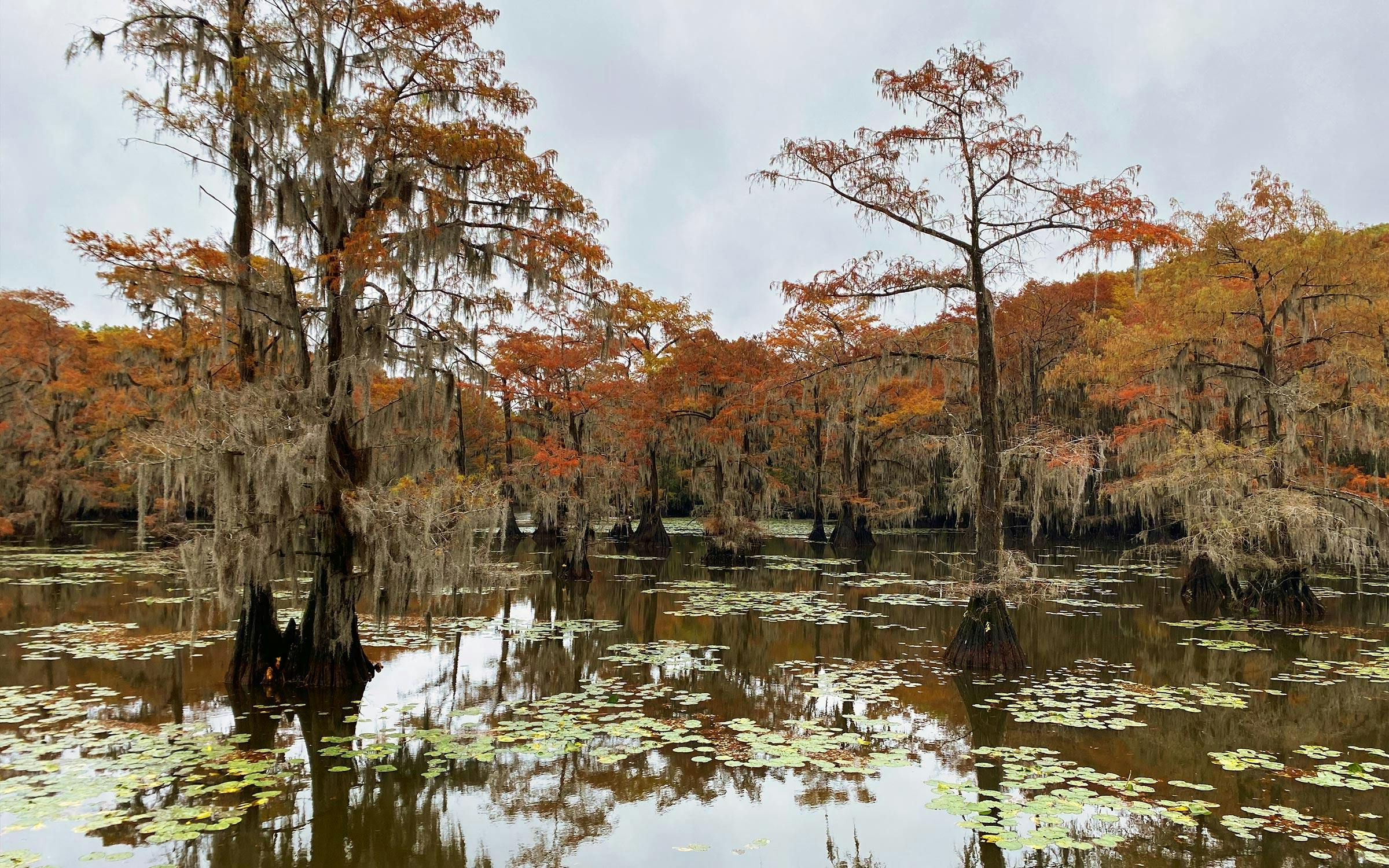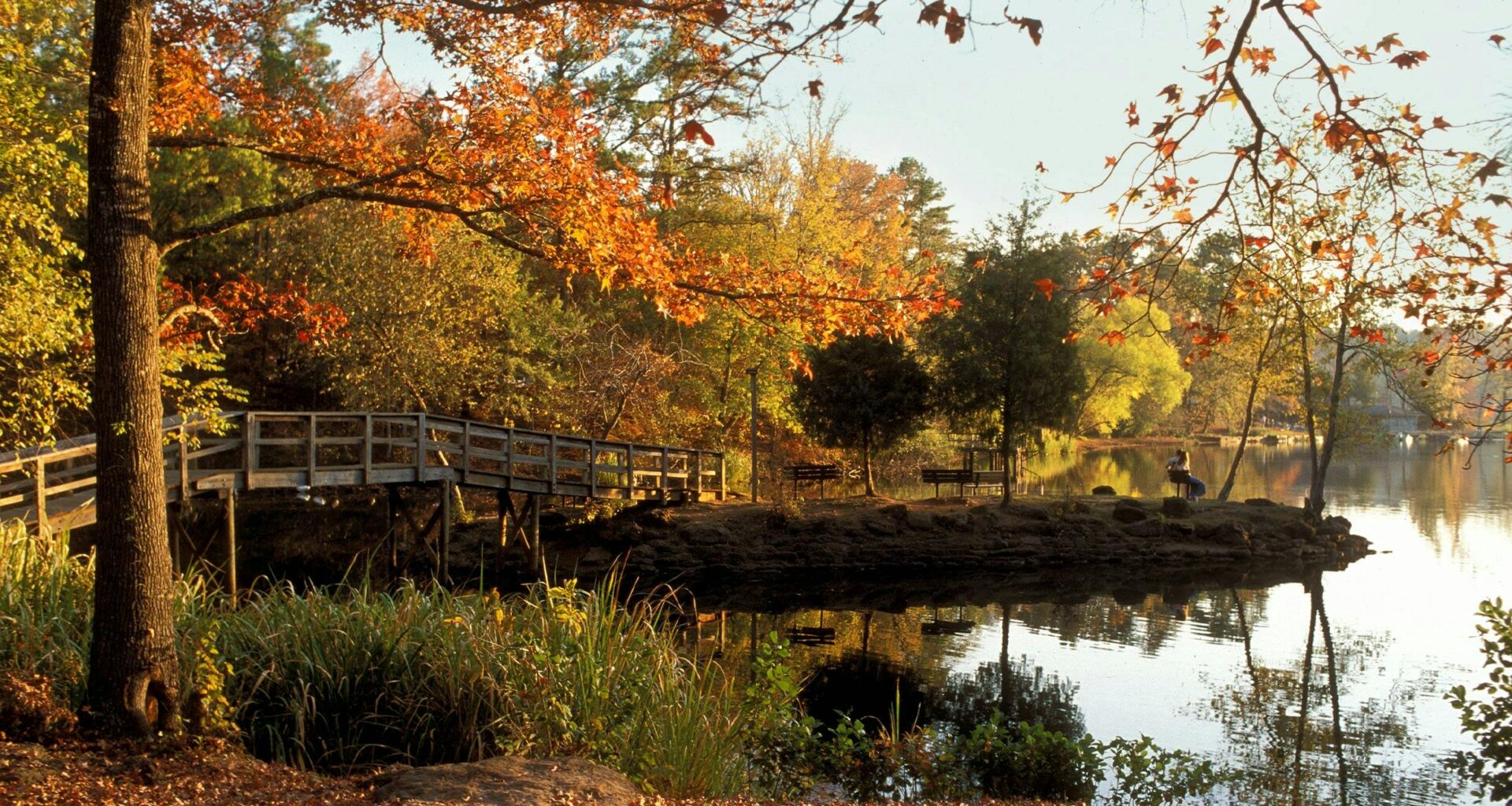The hundred-year-old pecan, oak, and cedar trees in my historic Junius Heights neighborhood were showing off some subtle yellow edges one evening in early October. Could it be due, I thought, to the turn of the year every Texan welcomes after the long slog of summer? Or perhaps it was merely because Dallas had received only an inch of rain in the past six weeks.
It was 85 degrees. My neighbor was making a bonfire as the sun began to set. “Getting into the fall spirit?” I asked him, noticing small beads of sweat on his brow. “Tryna,” he answered, looking for kindling among the dead twigs and branches lying on the ground—from a change of season or a drought, again, who’s to say.
I can’t judge my overeager neighbor. He is not alone in neighborhoods across Texas with inflatable Halloween decorations and giant skeletons flanking lawns since late September, in defiance of the persisting ninety-degree temperatures. I, too, had been feeling a need for Vermont-level leaves for a couple of weeks, so when I set out on a foliage quest in East Texas—an area that Texas Parks and Wildlife recommended to me for reliable fall colors—I counted my lucky stars to live only two hours away from (allegedly) a “real fall” experience.
As I began packing, I considered which flannel shirts, oversized hoodies, and beanies I should bring, even though they make me look like a logger. I checked the forecast: highs in the mid-eighties . . . but hey, lows in the sixties. Enough to pack a scarf, just in case, which I thought I might wear while reading my old copy of Meditations of John Muir, or Mary Oliver’s collection of essays on losing oneself in nature and literature, called Upstream, which I’d purchased for my trip.
I set out the day after a hunter’s moon, as The Old Farmer’s Almanac calls it. It was sunny and warm, with a hint of somber clouds on the horizon. At a pit stop in Terrell, I clocked 69 degrees, even though the sun was up. A Matthew McConaughey–style voice-over of Thoreau’s words crossed my mind as I pumped gas, wearing layers: “I went into the woods because I wished to live deliberately, to front only the essential facts of life . . .” The Piney Woods, actually, but I digress.
The first and largest of the three parks I visited on my quest was Tyler State Park, just north of America’s rose capital, as Tyler calls itself. Park superintendent Derek Dye said approximately 33,000 leaf seekers like me came through the park last October and November. He was the first to emphasize the importance of planning five months in advance to snag coveted campsites in the park system. Dye also reminded me that Texas State Parks celebrated its centennial anniversary in 2023. For the occasion, the Texas Parks and Wildlife Foundation raised money to support existing state parks—in addition to the boon of the $1 billion Centennial Parks Conservation Fund, a bond approved by voters that year that will add new parks to the state and expand existing ones. Thanks to the foundation’s own fundraising, Tyler State Park now has a viewing station with Chroma lenses that enhance the colors of the park’s two ecoregions.
When park interpreter Junior Rodriguez accompanied me to the viewing area, I noticed a group of people swimming. Rodriguez told me it’s not uncommon for folks to enjoy the leaves while taking a dip in the spring-fed lake. What Texas lacks in fall temperatures, it makes up for in water features to enjoy when leaf-peeping, particularly in East Texas, where lakes play a central role. I peered through the lens and spotted yellow at some of the trees’ edges.
Afterward, Rodriguez took me to the 0.3-mile Blackjack Nature Trail, on the south side of the park, where the ecosystem changes from Piney Woods to post oak savannah. He pointed out flame-tipped sumac and purpletop tridens and explained that when the post oaks begin to fully display their colors, around the second-to-last week of October, “what you’re seeing is the decay of the plant leaves and their cell walls,” which seems a little morbid if you think about it too much.

 Daingerfield State Park’s main trail winds around Little Pine Lake.Courtesy of Texas Parks and Wildlife Department
Daingerfield State Park’s main trail winds around Little Pine Lake.Courtesy of Texas Parks and Wildlife Department
Driving to Daingerfield State Park, I slowed down at the entrance to observe what appeared to be a wild, enchanted emerald forest. Like Tyler State Park, Daingerfield also boasts a central lake installed by young men in the Civilian Conservation Corps (CCC), President Franklin D. Roosevelt’s New Deal program to offset unemployment during the Great Depression. In addition to building park structures and planting trees to replace natural areas destroyed by logging and ore mining, they erected dams to create the spring-fed lakes at both parks.
A bathhouse erected by the CCC at Daingerfield has evolved into a dining hall by the main swimming area. Park superintendent Taylor Hackemack-Carter told me the lake is a big summertime draw and is mostly responsible for attracting the park’s 80,000 visitors each year. But she also claimed the park’s fall colors are ones she’d put up against those of quite a few state parks. Daingerfield’s exemplary showcasing of autumn colors is partly due to varied tree species. “Sweet gums, some maples, hickories, and quite a few oaks that’ll shift colors—along with a few cedar peppered in—that really makes fall a special time. They put on a spectacular show every year,” Hackemack-Carter said. The colors are a nice complement to enjoying Daingerfield’s perfect camping weather this time of year, hiking the park’s two trails, birding, or renting paddleboats, kayaks, canoes, and paddleboards.
As we hiked the quiet and pleasant 2.4-mile Rustling Leaves Trail, which is almost entirely shaded, I stopped to take a picture of the three to five trees beginning to sigh with umber, orange, and crimson. The hat I was wearing to protect against ticks and wrinkles was making me a little warmer than I would have liked, and I began to accept the ephemerality of leaf-peeping. As Annie Dillard wrote in Pilgrim at Tinker Creek, “Unfortunately, nature is very much a now-you-see-it, now-you-don’t affair.” So what if I was a little early. And hot.
For Restful Sleeps Near the Parks
That night, I deleted Instagram from my phone and camped in a red-and-white-mushroom-patterned tent at a peaceful homestead in Gilmer—peaceful except for my yelling out “Who’s there?!” at 3 a.m. when something approached. It was only Mow Mow, the homestead’s resident tuxedo cat, who simply wanted to join me inside and receive endless pets of her black-and-white patches as she purred in guttural alien noises.
Creaky, I drove the next morning to Caddo Lake State Park, the crowning glory of my journey. If only I’d arrived an hour earlier, I might’ve seen the preternatural mist that hovers above the world’s largest flooded bald cypress forest in the mornings. Here, where I felt I’d fully arrived in “West Louisiana”—one of East Texas’s nicknames—park interpreter Lane Neely told me people have lived near this natural lake for 12,000 years, including the Caddo, who reportedly gave Texas its name, from “tayshas,” meaning “friends.” What wasn’t friendly was the forced displacement of the Caddo to Indian Territory, which encompassed part of present-day Oklahoma, in 1859. But at least Neely began our talk by acknowledging their presence, and a few trail markers share some of their history.
Five Years After a Devastating Tornado, Caddo Mounds Reopens With a New Mission 
 Caddo Lake State Park’s swamp brings a certain moodiness to a fall-foliage escape.Courtesy of Lane Neely/Texas Parks and Wildlife Department
Caddo Lake State Park’s swamp brings a certain moodiness to a fall-foliage escape.Courtesy of Lane Neely/Texas Parks and Wildlife Department
Neely also told me about the floods and logjams (and, as Caddo legend has it, earthquakes) that formed the lake. He pointed out the “knees,” or short knobs of bald cypress roots that stick out of the water, and the “beards” of Spanish moss, so named for conquistadors—the plant isn’t Spanish or moss at all, but rather an epiphyte, an air plant related to pineapples. I found my attention drifting to Saw Mill Pond, which Neely thought looked like something out of Jurassic Park and was certainly otherworldly. I perked up when I heard him say he encourages everyone to go beyond the pier and get on the water. “Yeah, there are alligators,” Neely informed me, “but they’re pretty much the least of your worries. I tell everyone they should be more afraid of the mosquitoes.”
On the bayou, unworried but prepared to strike any alligators with my paddle, I experienced exactly what Neely described: my “own little Disney movie, where you disconnect from everything while also connecting.” No matter that the giant, drooping cypresses only had fall highlights at that point. Afterward, as I hiked the Caddo Forest Trail, the only examples of fall foliage I spotted were a couple of yellow flaps in a thicket of greenery. No matter—whoever is lucky enough to witness fall colors in full decay in a couple of weeks is in for a treat.
 Photograph by Trevor Paulhus For Fueling Up Near the Parks
Photograph by Trevor Paulhus For Fueling Up Near the Parks
When you buy a book using a link on this page, a portion of your purchase goes to independent bookstores and Texas Monthly receives a commission. Thank you for supporting our journalism.
Read Next

